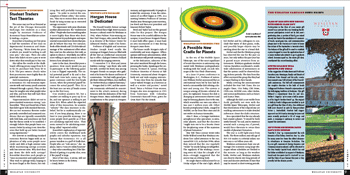Experiments in Economics
 The scene may not be as frenzied as the pit of the Chicago Mercantile Exchange, but students in a class taught by Assistant Professor of Economics Tanya Rosenblat are actively trading—in pens.
The scene may not be as frenzied as the pit of the Chicago Mercantile Exchange, but students in a class taught by Assistant Professor of Economics Tanya Rosenblat are actively trading—in pens.
Rosenblat is handing out free pens to half the members of her class on Experimental Economics and Strategic Planning. “Write down the price at which you would be willing to sell your pen,” she says. Then she asks those who didn’t receive a pen to write down what they would pay to buy one.
She tallies the results at the chalkboard: offering prices range from $.35 to $1.50; purchase bids from $0 to $.50. The pen owners clearly value their possessions more highly than do potential customers.
Such transactions go on all afternoon in Economics 311: real economic experiments with real money (small amounts obtained through a grant). They are the basis for insights into what people value and why, and how they will back their beliefs with action.
“Experimentalists didn’t set out to prove standard economics wrong,” says Rosenblat. “They just found lots of facts that didn’t agree with standard theories. We can test economic theories under precisely controlled and measured conditions that are typically unavailable with field data, and sometimes we find that the theory needs to be modified. I strongly believe that people learn economics better by acting it out. Even theories that hold up are better learned using experiments.”
Her interest in modifying standard economic theories began with an exploration of why some people incur credit card debt at high interest rates while maintaining savings accounts with low interest rates. Why don’t they pay down the debt with savings—Rosenblat describes such people as “time-inconsistent and sophisticated.” They wish to splurge today, hoping to be more frugal in the future, but realizing they will probably transgress again. “In order to restrict the consumption of future selves,” she continues, “they try to restrict their access to funds by tying money up in restricted savings accounts.”
The experiment with pens illustrates another phenomenon: the “endowment effect.” People who have something value it more highly than those who don’t. Experiments by psychologists and experimental economists have shown that people do behave this way. For instance, Book-of-the-Month and CD clubs take advantage of the endowment effect when they send you the selection first with an option to return it. Most likely, you will be more willing to spend money on the selection if you already have it.
Later in the class, Rosenblat poses a question: How much would you pay to participate in the following game: A coin is flipped repeatedly. The initial potential payoff is $2 and is doubled each time tails comes up. The game continues until the first heads occurs, when the potential payoff becomes the actual payoff. Thus $2 is the least you can win (if heads comes up on the first toss).
One student answers $0, but a number are willing to pony up $3 or $4, and one optimist is willing to put down $50. When asked the expected value of this transaction, he answers “infinity.” The class murmurs in disbelief, but he is mathematically correct. If you keep playing, there is no limit to your possible winnings. But some people don’t gamble as if they are calculating expected value. They seem instead to be calculating something called “expected utility.”
Rosenblat’s explanation of expected utility covers the chalkboard with graphs and calculus equations. Any fantasy that Economics 311 is all games vanishes in a puff of chalk dust. People who are “risk averse,” she explains, have a “concave utility function”—they value something less if the likelihood of getting it is pretty slim, even if the payoff is large.
Most of her class, it seems, will not be heavy betters in the lottery.

